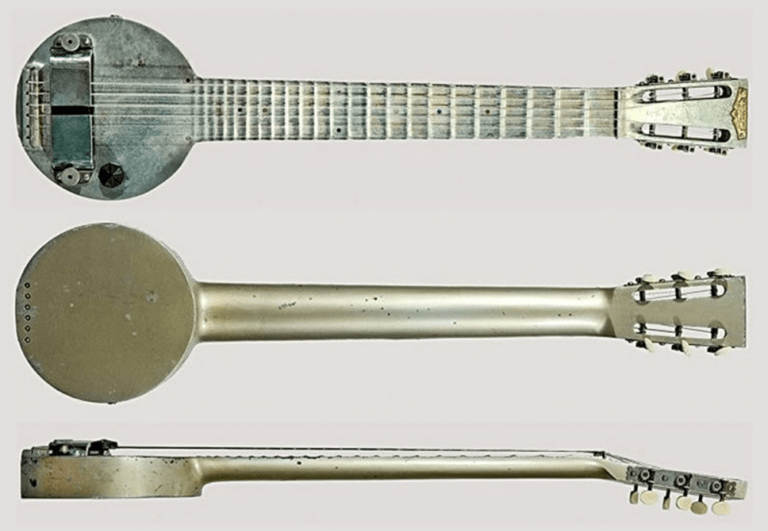Mashrufa Ibnat –
The Rickenbacker “Frying Pan” guitar, also known as the Rickenbacker A-22, is one of the most iconic instruments in the history of electric guitars. It is widely considered to be the first commercially successful electric guitar, and it has had a lasting impact on the evolution of popular music.
In the early 20th century, musicians were limited by the acoustic nature of their instruments. They could only be heard within the confines of a small room or concert hall, and they had to play loudly to be heard over the noise of the audience. Amplifiers were available, but they were bulky, expensive, and produced poor sound quality.
George Beauchamp, a Hawaiian guitarist, and inventor had an idea in 1931 that would forever alter the history of music. He was convinced that if he could use electromagnets to increase the sound of his guitar, he could develop a brand-new instrument that would be louder, clearer, and more adaptable than anything that had come before.

Beauchamp approached Adolph Rickenbacker, a production engineer, and machinist, with his idea. Rickenbacker was intrigued and agreed to work with Beauchamp to develop the world’s first electric guitar.
Together, the two guys created a guitar with a distinctive, round shape, made entirely of metal. Because of its likeness to the cooking tool, they called it the “Frying Pan”. The electromagnetic pickup on the guitar allowed it to translate the sound of the strings into an electrical signal that could be amplified.
The guitar was a ground-breaking creation that soon attracted the interest of artists all around the world. It was originally displayed to the public at the National Guitar Show in New York City in 1932, and it immediately became popular. The guitar’s distinctive tone and versatility were greatly admired by musicians. One of the earliest adopters of the Frying Pan was Hawaiian musician Sol Hoopii, who used the instrument to great effect on his recordings.

The Frying Pan guitar’s ability to play at higher volumes without distortion or feedback was one of the main ways it changed music. Before the invention of the electric guitar, guitarists were limited to using acoustic or resonator guitars, which lacked the volume and sustain of electric instruments. Because of this, guitarists found it challenging to compete with other musicians in a live situation, especially in jazz and swing ensembles where the brass and woodwind sections could easily outshine the guitar.
By using a magnetic pickup to transform the string vibrations into an electrical signal that could be amplified and played through speakers, the Frying Pan guitar found a solution to this issue. Due to the capacity to manipulate their sound using effects pedals and other processing instruments, guitarists were able to perform at higher volumes without sacrificing clarity or tone.
The Frying Pan guitar also increased the variety of sounds that guitarists could make, which had an impact on music. Acoustic instruments did not allow for experimentation with various playing methods like distortion, sustain, and feedback, but the electric guitar did. A larger variety of tones and textures may now be produced by guitarists, opening up new channels for musical expression.
The Frying Pan guitar was influential in the development of popular music styles such as rock and roll. Many early rock and roll guitarists, including Alvino Rey, Les Paul, Bob Wills, Charlie Christian, Benny Goodman, Eldon Shamblin, Eddie Durham, T-Bone Walker, Chuck Berry, Bo Diddley, and Link Wray, were influenced by the guitar’s distinctive sound and playing capabilities. These artists developed the distinctive sound of early rock and roll, which was distinguished by its high-energy rhythm and blues-inspired guitar riffs, using the bright, percussive tone of the Frying Pan guitar. The “power chord” sound, a mainstay of rock music in the 1960s and beyond, was developed in part due to the Frying Pan guitar’s capacity to produce sustain and distortion.
The Frying Pan guitar had a huge impact on guitar production and marketing as well. Before the Frying Pan, the majority of guitars were handcrafted and typically sold to professional players or affluent amateurs. But the Frying Pan guitar was made to be mass-produced with common components and assembly-line methods. As a result, Rickenbacker was able to build the guitars for less money, making them more affordable for working musicians. Also, the corporation aggressively promoted the instrument, highlighting its special qualities and talents. This contributed to the growth of the electric guitar market by increasing demand for them among consumers and musicians alike.
Rickenbacker discontinued making the Frying Pan during World War II and concentrated on producing other goods to aid in the war effort. Yet, as the guitar’s impact on popular music grew, it encouraged numerous other guitar makers to create their electric guitar versions.
The guitar was only produced for a short period, from 1931 to 1939, and only a limited number of examples were made. As a result, the “Frying Pan” is a rare and highly desirable instrument that is coveted by collectors.
So, what is the current market value of a Rickenbacker “Frying Pan” guitar? Though prices can vary widely depending on several factors, in general, you can expect to pay up to 50 thousand US dollars or more for one of these rare and historically significant instruments.



